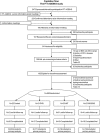Changes in Physical Fitness After 12 Weeks of Structured Concurrent Exercise Training, High Intensity Interval Training, or Whole-Body Electromyostimulation Training in Sedentary Middle-Aged Adults: A Randomized Controlled Trial
- PMID: 31105580
- PMCID: PMC6492765
- DOI: 10.3389/fphys.2019.00451
Changes in Physical Fitness After 12 Weeks of Structured Concurrent Exercise Training, High Intensity Interval Training, or Whole-Body Electromyostimulation Training in Sedentary Middle-Aged Adults: A Randomized Controlled Trial
Abstract
This study aimed to investigate the influence of different exercise training modalities [(i) a concurrent training based on physical activity recommendation from the World Health Organization group (PAR group), (ii) a high intensity interval training group (HIIT group), and (iii) a high intensity interval training adding whole-body electromyostimulation group (WB-EMS group)] on physical fitness in sedentary middle-aged adults. A total of 89 (52.7% women) middle-aged sedentary adults (53.7 ± 5.1 years old) were enrolled in the FIT-AGING study. Cardiorespiratory fitness was determined by a maximum treadmill test using indirect calorimetry. Lower, upper, and core body muscular strength were assessed by an isokinetic strength test, by the handgrip strength test, and by several core strength endurance tests, respectively. All the exercise types induced similar increases on cardiorespiratory fitness (Δ VO2max ≥ 11%, Δ maximal heart rate ≥ 8%, and Δ total test duration ≥ 14%; all P ≤ 0.034), as well as on muscular strength (Δ extension and flexion peak torque ≥ 10%, Δ total hand grip ≥ 3%, Δ core strength endurance tests ≥ 20%; all P ≤ 0.050) compared with a control group. In conclusion, our results suggest that a 12-week structured exercise intervention improves physical fitness regardless of the training program in sedentary middle-aged adults. Despite slightly greater improvements in some physical fitness variables, the changes observed in the WB-EMS group were not superior to the other exercise programs.
Keywords: HIIT; VO2max; WB-EMS; cardiorespiratory fitness; muscular strength.
Figures







References
-
- Amaro Gahete F. J., Alejandro De La O., Jurado Fasoli L., Castillo M. J., Gutierrez A. (2017a). Fitness assessment as an anti-aging marker: a narrative review. J. Gerontol. Geriatr. Res. 6:455 10.4172/2167-7182.1000455 - DOI
-
- Amaro Gahete F. J., Alejandro De La O., Jurado Fasoli L., Ruiz J. R., Gutiérrez Á. (2017b). Could superimposed electromyostimulation be an effective training to improve aerobic and anaerobic capacity? Methodological considerations for its development. Eur. J. Appl. Physiol. 117 1513–1515. 10.1007/s00421-017-3625-x - DOI - PubMed
-
- Amaro-Gahete F. J., De-la-O A., Sanchez-Delgado G., Robles-Gonzalez L., Jurado-Fasoli L., Ruiz J. R., et al. (2018a). Functional exercise training and undulating periodization enhances the effect of whole-body electromyostimulation training on running performance. Front. Physiol. 9:720. 10.3389/fphys.2018.00720 - DOI - PMC - PubMed
-
- Amaro-Gahete F. J., De-la-O A., Jurado-Fasoli L., Espuch-Oliver A., Robles-Gonzalez L., Navarro-Lomas G., et al. (2018c). Exercise training as S-Klotho protein stimulator in sedentary healthy adults: rationale, design, and methodology. Contemp. Clin. Trials Commun. 11 10–19. 10.1016/j.conctc.2018.05.013 - DOI - PMC - PubMed
LinkOut - more resources
Full Text Sources

